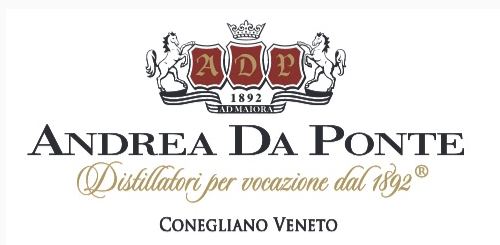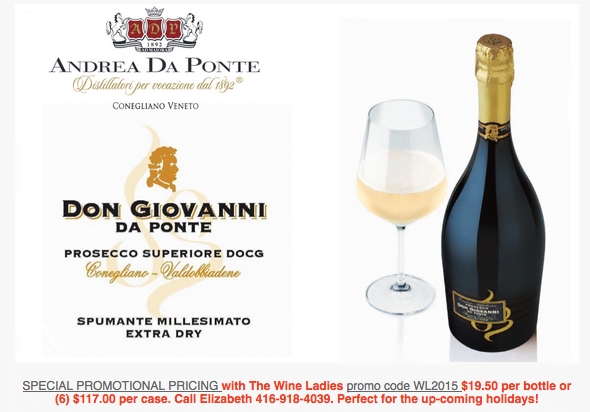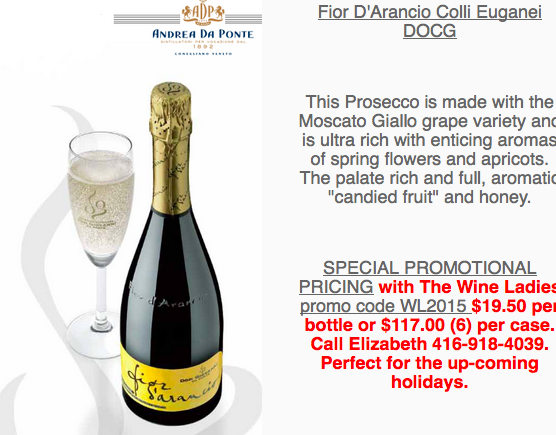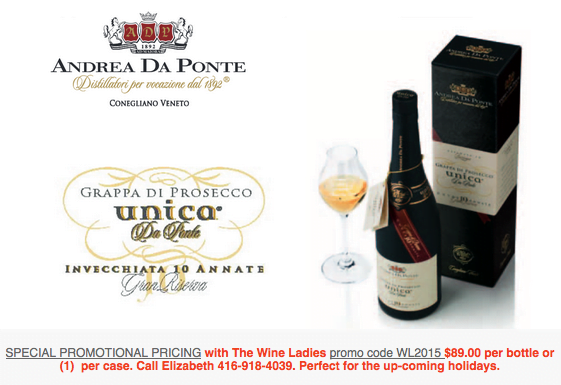Tag Archive for: Prosecco
Ask The Wine Ladies…Is Prosecco a grape or a place?
Dear Wine Ladies,
I am a bit of a novice when it comes to wine. At wedding I discovered recently how much I enjoy a glass of Champagne! I soon realized that this bubbly is a little out of my budget. I have since been introduced to Prosecco from Italy, which I thoroughly enjoy! This delightful bubbly, much more affordable has quickly become somewhat of a staple in our household.
I’d like to learn a little more about it, including my confusion as to whether it’s a grape or a place? Does it have to come from a specific part of Italy to be called Prosecco ? I have learned is the case with Champagne and is it made the same way?
Where can I find a rosé Prosecco, another of my favourites? Thanks Wine Ladies for your help. I am looking forward to learning more and enjoying more of this bubbly as spring approaches.
Hillary
Mississauga
Dear Hillary,
Congratulations, you have now joined the ever growing ranks of wine lovers, whether novice or not, smitten with this lively, delectable and affordable bubbly! Thanks for the great questions too. In fact there does seem to be a little confusion out there with respect to this ever popular sparkling wine.
In terms of where Prosecco must be made in order to be called Prosecco, you are right.
Just as is the case with Champagne, this sparkling wine must come exclusively from one of two wine growing regions in north eastern Italy. The regions are Veneto and Friuli-Venezia Giulia. In fact the name comes from the Italian village of Prosecco near Trieste which is the capital of Friuli-Venezia Giulia. Curiously Prosecco is also the name of the wine. And was until recently the name of the grape. Due to a change in regulation in 2009 the “Glera” grape which is a long standing synonym for Prosecco was officially recognized as the proper grape name used to identify this iconic Italian export.
One of the main attractions of Prosecco, besides it having a lively, zesty and cheerful flavour, is of course its affordability.
In contrast to Champagne which can be explained partially at least in the way these two sparkling wines are produced. Champagne undergoes its secondary fermentation in the bottle, which is costly, takes time and is labor intensive, while Prosecco’s secondary fermentation takes place in a large stainless steel tank, much more economically, known as the Charmat method. Of course there are other reasons why Champagne fetches the prices it does, and all very well deserved indeed.
Looking for a rosé Prosecco? You can find a rosé sparkling wine, otherwise known as spumante, or a rosé frizzante but because Prosecco must be a white wine and Pinot Noir is not among any of the permitted grapes for making Prosecco, this will not be possible. There are however some absolutely delectable rosé Spumantes on the market, which do hail from this unique region of Friuli.
We recently had the opportunity to interview Nicola Pittaro, of Pitars winery, a fourth generation, historic and stunning winery located in Friuli, who was visiting here showcasing his wines.
Nicola treated us to an extensive tasting of a suburb line up of sparkling wine. We sampled their Prosecco, as well as their Pitars Rosé Spumante, which was elegant, delicate, dry with hints of strawberry and raspberry, very delicious. They also produce a sparkling wine using one of the indigenous grapes of the region, the Ribolla Gialla, also delightful. If you would like more information on the various aspects of Prosecco, either on the region or on the wines, please tune in to our radio show www.connectmeradio.com and get the scoop from Nicola himself. The three above mentioned wines are available by the way here in Ontario, through VDF Imports located right here in Mississauga. Cheers.
VDFWines.com Contact: Dan Scodellaro
Festive Fizz! In love with Champagne and Prosecco.
Fabulous premium Prosecco, Andrea Da Ponte SAVE $$$$$
On this week’s radio show…
La Dolce Vita,”the sweet life!”
Episode 34
Plus a Michelin starred Italian Chef, with a spectacular restaurant in the historic, culturally rich gastronomic capital of Rome.
To get things started we are going to kick off the show with a little bubbly.
This is no ordinary bubbly, this Prosecco from Veneto of course, hails from the DOCG region of Conegliano-Valdobbiadene. It is made from the finest premium grapes and is produced by the long established award winning house of Andrea Da Ponte, founded in 1892.
And from there,this dynasty of a company Andrea Da Ponte Distillery, actually started out over 120 years ago as a distillery. Brothers Andrea and Matteo, were so dedicated to the art and science of producing the finest distillate, that they wrote and published the first printed manual ever on the subject. Historical figures, now producing among the finest grappa in the world…Christian to fill us in on the Andrea Da Ponte grappas, what makes them so unique and outstanding!
You can take this special sparkling fizz anywhere, anytime! Cheers, Salute or Prost! Bubbles & Bites as read in Arabella Magazine.

Never one to sit on our laurels, we are now armed with saber and flutes, on our current crusade to bring Champagne and Sparkling wines to the people!
We hope you’ve been enjoying the multitude of wonderfully delicious and diverse alternative white wines we chatted about last issue.
As you may recall we were champions for the ABC Club. Where we introduced our top ten alternative white wine choices outside the dominant domain of the almighty chardonnay. Hence the “Anything but Chardonnay” Club.
Never one to sit on our laurels, we are now armed with saber and flutes, on our current crusade to bring Champagne and Sparkling wines to the people!
With a plethora of brilliant bubblies now being produced from around the world, there’s a sparkling wine for you, just waiting to pop its cork. And yes, fabulous for festivities but also perfect for partnering with an array of foods due to its vibrant acidity. That acidity can act as a turbo charger for flavour in a recipe too, so say our award winning Chefs who have created sumptuous recipes just for us, using sparkling wine as a key ingredient. We’ll begin our journey by exploring a variety of ways of saying “bubbly” from Champagne to Cava, to Prosecco and Sekt.

Champagne Tattinger
First stop, we’ll linger here a while, the most famous wine in the word, synonymous with glamour, celebration and decadence, Champagne.
The name alone elicits images of excitement, of joy, of success, romance, and beautiful people! amazing the power of a 9-letter word!
Speaking of which, a few perfunctory words on Champagne, if you will. Champagne is a place, a wine-growing region approximately 90 miles northeast of Paris. In order for a sparkling wine to be called champagne, it must come from this A.O.C. (appellation d’origine controlee) region and follow the rules of production as outlined by the meticulous Classic Method, or Methode Champenoise.
What makes Champagne so special? It’s the combination of the soils, the terroir and the grapes that uniquely blend to provide the ultimate ingredient for the finest sparkling wine in the world. The producers, or Champenois as they say in Champagne, have the advantage too of experience and skill, with over three centuries, practice makes perfect!
Champagne comes to us in many styles, from the Blanc de Blanc, made exclusively with Chardonnay, the Blanc de Noirs, you got it, red grapes only, and rose champagnes too. Pink or rose Champagnes are made by either adding a small proportion of red wine to the blend or less commonly, allowing the juice to remain in contact with the dark skinned grapes for a short time during fermentation. Vintage Champagnes, typically 3 or 4 only in a decade, and Prestige Cuvees representing a champagne house’s best, are also out there; the possibilities are endless.
When it comes to a toast, Champagne obviously rules as the beverage of choice, but what about as an aperitif, or as a partner to accompany you throughout your meal from appetizers to dessert? And at snack time, there’s nothing better than Champagne with potato chips! Perhaps an NV Brut would be nice?
With all the different styles of champagne, there’s a bottle of bubbly to suit every occasion, every dish and everyone’s palate! For a few Champagne and food pairing tips, read on!
Champagne and oysters: well known to be a match made in heaven. Opt for a delicate young Brut Champagne. The acidity acts like a squeeze of lemon, while the crisp bubbles counter the fatty slippery texture of the oyster.
Blanc de Blanc Champagnes are elegant and tangy, they go well with lighter style foods beautiful, with goat cheese and sushi.
Blanc de Noirs Champagnes have the complexity of red wines and are well suited to lighter meat dishes such as veal, partridge or pigeon.
Brut Champagnes, crisp and dry with good acidity cut through the fat of fried foods!did we mention potato chips? Oh yes, we did, obviously a weakness of ours.
Serve the sweeter Champagnes with fresh fruit, berries and other desserts that are not too sweet.
Is this a dry style Champagne or sweet? If it says Brut on the label the wine is totally dry. Other styles from least to most sweet, are; extra dry, sec (dry), demi-sec (off-dry) and doux (sweet)
The question beckons, is there any time a Champagne just won’t do? Here’s what Madame Lilly Bollinger of Bollinger Champagne, and James Bond movie fame, said when asked her opinion “I drink it when I am sad. Sometimes I drink it when I am alone. When I have company, I consider it obligatory. I trifle with it when I’m not hungry and drink it when I am. Otherwise, I never touch it unless I’m thirsty”. Well said, Madame, The Wine Ladies couldn’t agree more!
Moving on, although Champagne is dear to our hearts, other sparkling options await us, wonderfully delightful and unique with new flavours and styles to embrace.
Spain is our next stop with its incredibly valued sparkling wine, they call Cava.
Easy on the pocketbook, and easy to enjoy any time any where, these bubblies will please your palate by their lonesome, in a cocktail or with a variety of dishes. Finding great Cava under $20.00 is not unusual.
Cavas are made in the classic method, and just as in Champagne are restricted to certain grape varieties. They too must come from a list of designated municipalities including Catalonia. This is where close to 95% of all cava is produced. One of the reasons Cava is so affordable is the widespread use of highly efficient modern methods of production. Keeping the costs way down. This coupled with high-yielding grapes provides a winning price/quality ratio for Cava. The proof clearly being in the bottle.
A Reserva Cava with a pronounced yeasty, toasty character or a Cava Rosado, a rose with attractive red fruit such as cherries and blackberries are wonderful introductions to the world of Spanish sparkling.

Cava at Codorniu Cellars in Spain
Prosecco, a spirited sparkling wine, and a white grape variety native to the Veneto region in north east Italy.
The home to Verona, the setting of Shakespeare’s Romeo and Julliet. For the jet set, also the base for the famous Bellini cocktail.
This fashionable sparkling wine from Veneto is steadily gaining in popularity. Showing off its allure of freshness and simplicity, clean and lean. No yeasty, buiscuity quality here, as with Champagne. Expect mineral notes, lemony, apples and pear, soft and inviting. The bubbles are a little less tight, having been fermented in a tank. Most often, as opposed to the bottle, but that’s ok, for this uncomplicated well priced sparkling, Prosecco delivers well. Partnering Prosecco with a variety of appetizers is no difficult task either, with their fruit and crisp acids, plus the lively bubbles handling salty or fatty dishes is no problemo!

Foss Marai Extra Dry Prosecco
Finally we come to Sekt, the term used in German speaking countries to describe sparkling wines.
We salute the wine lovers of Germany. They appreciate the joy and diversity of sparkling wines being among the highest consumers/capita in the world.
There are several quality levels of Sekt available for our enjoyment. We would encourage you to seek out those sparklers labeled either Deutscher Sekt or Sekt bA. Simple Sekt, is a sparkling wine that is made with grapes from other countries, while Deutscher Sekt of course uses German grapes.
Taking it one step further, if you can source a Sekt b.A. (b.A. means from a specific region) these sparkling wines are the pick of the crop! Sort of to speak. Finally, “the piece de resistance”, we said there were several levels, when it comes to Sekt is finding a b.A. This includes a vineyard site, the name of the grape varietal, and/or a vintage. These are the superior sparklers, having undergone strict quality control. Our absolute favorite has got to be, unequivocally, those Sekt which are made with the noble grape variety, the aromatic and racy, Riesling. With its pronounced acidity, these wines are ready and able to do table duty at any time and any place.

Kessler Sekt – Germany’s oldest sparkling wine producer
I hope we’ve made a compelling case for the bubbly, the one that sparkles, that enchants, that knows, no boundaries. From a toast, Cheers, Salute or Prost, to an appetizer, through to dessert, you can take this special fizz anywhere, anytime!. and you can take that straight to the bank! Speaking of banks, there’s no need to break that either, thanks to the multitude of superb value sparkling wines just waiting to be popped! Explore, experience and enjoy! Did we mention, that a silent hush, rather than a thunderous popping cork is the preferred way of opening Champagne?
Cheers everyone, and please do email us with any sparkling wine favorites, recipes or stories, we’ love to hear from you! We’re twittering too, we’re on facebook and we’re scouting for fans! Have a superb summer, we’ll be back in the fall.

Arabella Magazine featuring The Wine Ladies article Bubbles & Bites. Summer 2009












